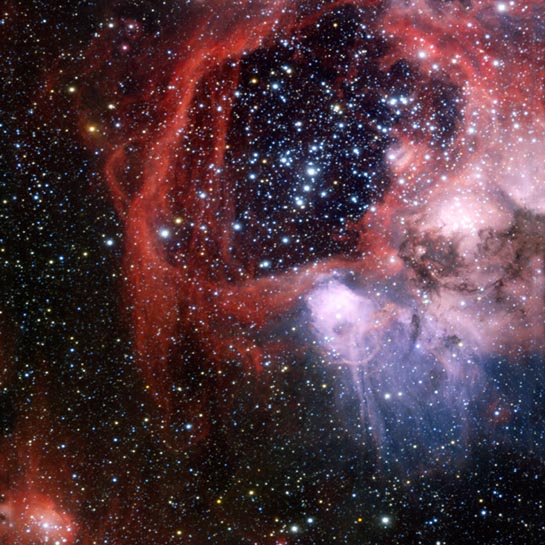
Large Magellanic Cloud
Description: Star Cluster
Position (J2000): RA 5 22 7.93 Dec -67° 56' 14.12"
Constellation: Dorado
Distance: 170,000 light years
Field of view: 6.17 x 6.37 arcminutes
Orientation: North is 0.0° left of vertical
ImageCredit: ESO/Manu Mejias
Release date: July 20, 2011
Wider view: S1208
ABOUT THIS IMAGE:
ESO's Very Large Telescope captured this striking view of the nebula around the star cluster NGC 1929 within the Large Magellanic Cloud, a satellite galaxy of our own Milky Way. A colossal example of what astronomers call a superbubble dominates this stellar nursery. It is being carved by the winds from bright young stars and the shockwaves from supernova explosions.
The Large Magellanic Cloud is a small neighboring galaxy to the Milky Way. It contains many regions where clouds of gas and dust are forming new stars. One such region, surrounding the star cluster NGC 1929, is shown in close-up in this new image from ESO's Very Large Telescope. This nebula is officially known as LHA 120-N 44, or just N 44 for short. Hot young stars in NGC 1929 are emitting intense ultraviolet light and causing the gas to glow. This effect highlights the aptly-named superbubble, a vast shell of material around 325 by 250 light-years across. For comparison, the nearest star to our Sun is just over four light-years distant.
The N 44 superbubble has been produced by the combination of two processes. Firstly, stellar winds - streams of charged particles from the very hot and massive stars in the central cluster - cleared out the central region. Then massive cluster stars exploded as supernovae creating shockwaves and pushing the gas out further to form the glowing bubble.
Although the superbubble is shaped by destructive forces, new stars are forming around the edges where the gas is being compressed. Like recycling on a cosmic scale, this next generation of stars will breathe fresh life into NGC 1929.
The
image was created by ESO from observational data identified by Manu Mejias,
from Argentina, who participated in ESO's Hidden Treasures 2010 astrophotography
competition